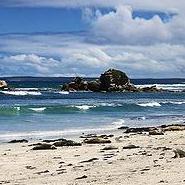 目前的澳洲西南海域,面對過度捕撈、石油洩漏等威脅只有不到1%受到保護;根據11日公布的一份海洋管理計畫建議書指出,該海域應有一半納入海洋保護區網絡,以降低海洋生物、魚類和生態系統的危機。
目前的澳洲西南海域,面對過度捕撈、石油洩漏等威脅只有不到1%受到保護;根據11日公布的一份海洋管理計畫建議書指出,該海域應有一半納入海洋保護區網絡,以降低海洋生物、魚類和生態系統的危機。
這是澳洲史上第一個具有科學基礎的海洋管理規劃,由昆士蘭大學生態中心和國內44位海洋與社會科學家的參與,經過2年研究分析所完成的。其目標是為了保障海洋生物的生存,同時也能保障經濟和社會利益。
這項計畫是皮尤慈善信託基金(Pew Charitable Trusts)所委任,而由波西翰教授(Hugh Possingham)和生態中心其他4名科學家獨立進行,此計劃在2009年10月21日完成。
預計在今年稍晚,聯邦政府將會依研究結果,做出澳洲西南海域成為新海洋保護區的決策。
「面對經濟發展造成的巨大不確定性、以及持續增加的壓力,這份為西南海域作的藍圖代表著達成高品質成本效益的海洋保護區及保育結果最佳的科學實證。在西南海域進行廣泛的分析和研究,將可避免我們對海洋知識的不足,並幫助政府規劃人員在設計保護區時,做出更準確的決策。」波西翰教授如此表示。
11個環保團體組成的聯盟說,昆士蘭大學的規劃代表著澳洲在海洋保育領域上成為世界領袖的歷史契機。
「拯救我們的海洋生物聯盟」(Save Our Marine Life alliance)說,科學研究將提供聯邦政府所需的訊息,以對於在西南海岸地區建立海洋保護區聯絡網,做出精確的決定。
 「在西南海域建立大型海洋保護區聯絡網的科學證據是不容辯解的。」世界自然基金會澳洲分會的盧埃林(Dr. Gilly Llewellyn)說。
「在西南海域建立大型海洋保護區聯絡網的科學證據是不容辯解的。」世界自然基金會澳洲分會的盧埃林(Dr. Gilly Llewellyn)說。
「昆士蘭大學為澳大利亞西南海域設計的藍圖告訴我們,我們可以保護獨特的海洋生物,並確保能從海洋得到漁業經濟的永續利益。」澳洲自然保護基金會史密斯(Chris Smyth)說。
西南海域環繞在澳洲聯邦海域外圍,從南澳的袋鼠島附近水域往南延伸到西澳的世界遺產區域鯊魚灣附近。該地區佔地面積約120萬平方公里的海域、大陸棚和深海生態系統,並包含許多特有物種和獨特的特質。
根據該報告,在西南海域發現到一個比大堡礁更大規模的獨特海洋生態系統。
生態中心提出50%保護範圍的建議,這將可對1465個物種提供保障措施,包括了哺乳動物、魚類、鳥類和無脊椎動物。這些保障措施將涵蓋「環境保護與生物多樣性保育法」(Environment Protection and Biodiversity Conservation Act)所保護的57種魚類和海洋生物。該計畫也將保護486個支持海洋生物的水下特徵,例如,不同水深區塊、海景形態、地貌結構和魚類群聚狀況。
這份計畫書名為《系統化保育計畫──西南海域海洋保護區網絡》,其中還詳盡敘述如何保障海洋生物、及擴大保護區解決方案以兼顧經濟和社會利益。
昆士蘭大學也發布了「設計澳洲海洋保護區的科學原則」(Scientific Principles for Design of Marine Protected Areas in Australia),這是由44位諮詢科學家執筆,內容中對於選擇、設計和實施海洋保護區提供了同儕指導意見。
研究人員使用Marxan軟體,能夠確定西南海洋保護區網絡的位址,這不僅符合前述科學原則,並使現有的海洋活動如航運、石油開發、商業和休閒漁業等的衝擊最小。
「聯邦政府現在有了科學證據,能夠對澳大利亞西南海洋和海洋生物未來的健康考量作重要的決定。」西澳保育委員會成員尼科爾(Tim Nicol)說。
波西翰認為該計畫的原則能夠擴展到所有的澳洲海域,他說:「我們為澳洲亞西南海域所做的設計,也可以推展到幫助管理、保育這個國家的西北、北部和東部海域。」
Half of the marine region to the south west of Australia will need to be protected in a network of marine sanctuaries to minimize risks to marine life, fish stocks and ecosystems, finds the first science-based plan for managing Australia's oceans, unveiled today.
Currently, less than one percent of Australia's South West Marine Region is protected from threats such as overfishing and oil spills.
The result of two years of analysis by the Ecology Centre at the University of Queensland and the involvement of 44 of the country's marine and social scientists, the plan has been developed to safeguard marine life and at the same time protect economic and social interests.
The report was commissioned by the Pew Charitable Trusts but was prepared independently by Professor Hugh Possingham and four other scientists from the Ecology Centre. Dated October 21, 2009, the plan was released today.
The federal government is expected to rely on the study to make decisions for new marine sanctuaries in Australia's South West Marine Region later this year.
"This blueprint for the South West represents best scientific practice to achieve high quality cost-effective marine sanctuaries and conservation outcomes in the face of vast uncertainties and ever-growing pressures for economic development," said Professor Possingham.
"The extensive analysis and research conducted in the South West will plug a hole in our knowledge of our oceans and help government planners make much more accurate decisions when designing protected areas," Professor Possingham said.
The University of Queensland plan represents a historic opportunity for Australia to become a world leader in marine conservation, said an alliance of 11 environment groups.
The Save Our Marine Life alliance said today that the scientific study will provide the federal government with the information it needs to make accurate decisions about establishing a network of marine sanctuaries in the South West Marine Region.
"The scientific evidence in support of a network of large marine sanctuaries in the south west is compelling," said Dr. Gilly Llewellyn from WWF Australia.
"The University of Queensland's blueprint for Australia's southwest oceans shows us that we can protect our unique marine life and ensure that we can continue to fish and benefit economically from our oceans," said Chris Smyth from the Australian Conservation Foundation.
The South West Marine Region encompasses Commonwealth waters from near Kangaroo Island in South Australia extending to waters near Shark Bay, a World Heritage Area in Western Australia. The region covers about 1.2 million square kilometers of coastal waters, continental shelf and deepwater ecosystems, and contains many endemic species and unique features.
There is a far greater level of unique marine life found in the south west than on the Great Barrier Reef, according to the report.
The 50 percent level of protection recommended by the Ecology Centre would afford safeguards to a total of 1,465 species from mammals, fish and birds to invertebrates.
Safeguards would cover 57 species of fish and marine life listed under the Environment Protection and Biodiversity Conservation Act.
The plan also would protect 486 underwater features supporting marine life, such as depth zones, seascape types, geomorphic structures, and fish assemblages.
The report, "Systematic Conservation Planning - A Network of Marine Sanctuaries for the South West Marine Region," details ways to safeguard marine life and protect economic and social interests by maximizing the compactness of good sanctuary solutions.
The University of Queensland also released Scientific Principles for Design of Marine Protected Areas in Australia written by the 44 consulting scientists, which provides peer-level guidance on the selection, design, and implementation of marine protected areas.
Using the Marxan software, researchers were able to identify the location of a network of marine sanctuaries in the south west that meet the Scientific Principles and also have the smallest impact on existing ocean uses such as shipping, petroleum development, and commercial and recreational fishing.
"The federal government now has the scientific evidence it needs to confidently make important decisions about the future health of the oceans and marine life in Australia's south west," said Tim Nicol from the Conservation Council of Western Australia.
Professor Possingham sees the principles behind the plan as extendable to all of Australia's marine areas, saying, "What we have designed here for the oceans of south west of Australia can now be rolled out to help make more accurate decisions for managing and conserving the north west, north and east marine regions of the country."
全文及圖片詳見:ENS報導





